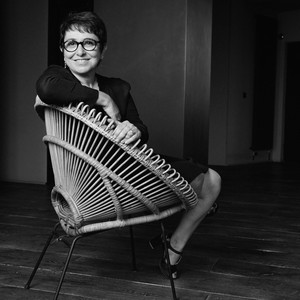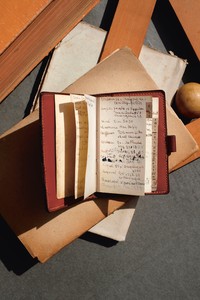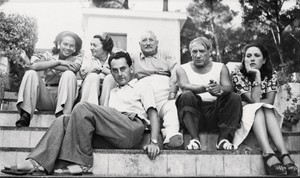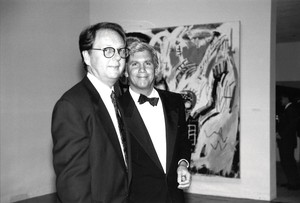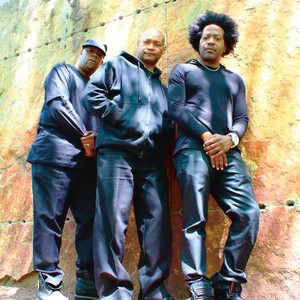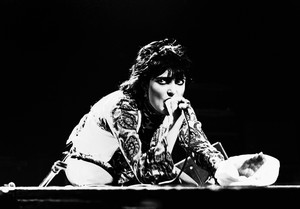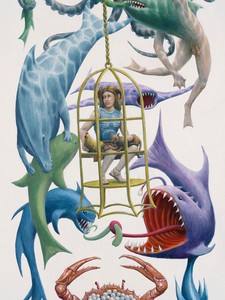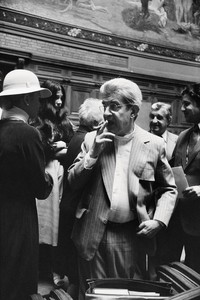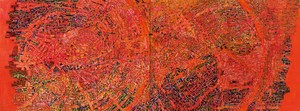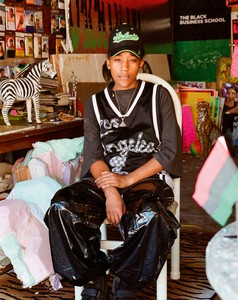Before the found object, there was the lost object: a small Hermès datebook that my husband had for years. A miracle he kept it so long; he spends his time losing things. A second happy chance was the salesperson’s polite but definite response when he wanted to buy the same datebook again: “They don’t make this leather anymore.” Another man would have been satisfied with a different leather—full-grained, striated, crocodile . . . but my husband never gives up: he found his bliss on eBay under “vintage leather goods.”
It arrived by mail, well packed in bubble wrap. Same size, same leather, a bit redder, a bit older. Of course I opened it; a little address book was still slipped into an inside pocket. I leafed through it absentmindedly before noticing a name: Cocteau. Then below it, Chagall . . . Then Éluard, Giacometti, Ponge, Poulenc, de Staël. A frenzied return to the first page: Aragon, Breton, Brassaï, Braque, Balthus. Twenty small pages listed the greatest European artists of the postwar period in alphabetical order. At the very end, a calendar gave me a date: 1951.
Obviously I wanted to know: who had written these numbers in brown ink? Who could have been the friend of all these geniuses? A genius him- or herself, surely. I wasted several weeks trying to find the seller. After a dozen or so emails back and forth with an auctioneer in southwestern France, I realized that I’d have to find the answer alone, by subjecting the book to a kind of interrogation.
Like an investigator facing a key witness, I began with careful observations of the book, then tallied the information it was willing to give me with an old telephone directory that I found in a secondhand shop. The book told me about painters, poets, gallerists, patrons, and a psychoanalyst. I found a hairdresser, a beauty salon, a furrier, a canvas man. Things were coming into focus: I suspected a woman, a painter, in Lacanian analysis, and with close ties to the most famous of the Surrealists.
Yet it was an illustrious unknown, Achille de Ménerbes, who ended up betraying the book’s owner. I spent a crazy amount of time researching online, but all I really needed was a magnifying glass: she hadn’t written “Achille de,” but “Architecte”—“Architecte de Ménerbes” (Ménerbes architect). So she had a house in that small village in the South of France and she needed an architect to oversee construction. The Wikipedia page on Ménerbes notes only two painters having lived there. The address book’s owner hadn’t been Nicolas de Staël, because he was listed in it. So it was Dora Maar! Everything was coming together, it all made sense, even the absence of her lover Pablo Picasso, who had left her in 1945. The address book I’d purchased by accident was Maar’s.
At the time, I only knew the basics of Maar’s story: Picasso’s “weeping woman” portraits, of course, and the photographs she took of the artist, on the beach or while painting Guernica. Bless Google! I learned more about her in twenty minutes than I had in twenty years: “Dora Maar, the great photographer and French painter, Picasso’s partner.” “An influential figure of the twentieth century.” “Friend of André Breton and the Surrealists.” “Pablo Picasso’s lover and muse, a role that overshadowed her work as a whole.” “Picasso left her in 1945 for the young Françoise Gilot.” And so forth. Bits of life, shards of suffering: institutionalization, electroshock treatments, madness, psychoanalysis, God, isolation. I also read the Paris gallerist Marcel Fleiss’s account of his dealings with Maar, written a few years ago—it was Fleiss who had organized the last exhibition during her lifetime, in 1990. He responded immediately to the email I sent to his gallery: “Come see me at FIAC,” the annual Paris art fair.
It took Fleiss less than five minutes to authenticate Maar’s handwriting. He equally immediately passed on his memories of her, an old woman when he met her, a recluse in an unkempt Paris apartment, cantankerous and distrustful. He would never forget the copy of Mein Kampf in her library, and that terrible moment when, before agreeing to sell him photographs, she asked him to swear that he wasn’t Jewish. 1 But who could resist the call of those names: Breton, Louis Aragon, Jean Cocteau, Jacques Lacan, and especially the ghost of Picasso. And so I found myself dragged into that battalion of women who for years have taken a passionate interest in Maar: biographers, writers, art historians, gallerists, and more.
My path would be different: besides the fact that I had not chosen her, I had the miraculous address book as a guide. I would ask the same questions of every name: What is this person doing in this book? What was this person doing in her life? I hesitated before deciding where to start, wavering between chance and alphabetical order, and finally opted for a vague chronological order: “Lamba, 7 Square du Rhône.” Jacqueline Lamba is everywhere described as Maar’s oldest friend. They met as young and ambitious students at the Union centrale des arts décoratifs, very committed to left-wing causes. Their charm was incredibly effective: one married Breton, the leader of the Surrealists; the other became the partner of the century’s greatest painter. But whereas Maar, after Picasso left her, devoted herself to God and became a conservative, Jacqueline left her genius spouse of her own accord and stayed true to her first rebellions to the end of her life.
I was considering the astounding trajectories of these two twentieth-century women when an email from Fleiss put an abrupt end to my wanderings: “I had dinner with Aube, Jacqueline Breton’s daughter. Her mother never lived at the address in the book.” Again, bless Google! It was Jacqueline’s sister, an obscure piano teacher called Huguette, who had lived there. Luckily, before her death, Huguette Lamba told an art historian, whom I was able to track down, about the connection between herself and Dora. In September 1940, after France had surrendered to Germany and half the country was occupied, the Bretons, having taken refuge in the South, finally obtained a visa for the United States. From the boat that allowed them to escape France, Jacqueline wrote a last letter to Maar, imploring her friend to take care of Huguette, who was pregnant and alone in Nazi-occupied Paris. Maar had just learned that she was infertile, for which Picasso reproached her relentlessly. Through Huguette she would now experience a kind of proxy pregnancy, and when the child was born, she naturally asked to be its godmother. Unfortunately the little girl lived only five months, and this was when Maar first became interested in religion, initially Buddhism, then Catholicism. To flesh out the story, I asked for the name of Huguette’s child. My confidant hesitated, then whispered, “Brigitte.” I confirmed with public records: the girl did indeed have the same name I do. I’m too rational to see this as anything but coincidence, but it was unsettling. Would I dare tell my confidant that Jacqueline’s letter was mailed from Ghazaouet (then called Nemours), Algeria? Ghazaouet is a small fishing town on the Moroccan border, no one knows it—but I lived there for the first three years of my life.
Other surreal coincidences would punctuate and facilitate my investigation. A friend, for example, remembered that she knew an art historian working with an important Picasso biographer in New York: “I can put you in touch if you’d like.” And that’s how, thanks to Delphine Huisinga, I met John Richardson. I can see him still, hovering over the little address book, bringing it up to his tired eyes, and finding friends in it: Marie-Laure de Noailles, Balthus, Óscar Domínguez, and especially Douglas Cooper, the great collector and Cubism expert who was once his partner. Richardson died before I could get back to New York to see him again, but one of the last things he said to me has continued to haunt me: “You’ll never understand Dora Maar if you don’t remember that she was a masochist.” I found nothing about this in Lacan’s archives, but other psychoanalysts to whom I sent my Dora dossier came to the same conclusion as Richardson.
In following the book word for word, I also met some twenty heirs of various artists: in Ménerbes, the son of Nicolas de Staël; in the English countryside, the son of Roland Penrose and Lee Miller; in Paris, the daughter of Breton, the daughter of the poet Francis Ponge, the niece of the painter André Marchand; and others. I consulted historians, museum directors, art dealers, experts, and enthusiasts. But I never imagined that I would be talking directly to any of the friends of Maar’s named in the book; after sixty-eight years, I was sure, they would all have passed away. When I came to the Belgian filmmaker Étienne Périer, though, I found that no death date appeared for him anywhere online. And for good reason: at the age of eighty-seven, he was alive and well in the South of France, and he even answered the telephone. Périer remembered Maar well, having met her in Saint-Tropez in 1950 through a friend who was a sculptor. He was not yet twenty years old, while she was in her forties; he got the impression of someone charismatic, dark, temperamental, and self-centered. No one was allowed to ask about Picasso, but she talked about him sometimes: without actually speaking ill of him, she managed to complain about him, insinuating that the genius was letting her live in misery. Périer did not know that she had put down his name in her address book.
A few names remained a mystery to me: Katell, Camille, Madeleine, probably scribbled down to be read only by the writer. I also gave up on relationships that seemed too distant: Aragon, Ponge, the composer Francis Poulenc, for example. Other, more unexpected characters emerged: a graphologist, the poet André du Bouchet, the painter Marchand. Today Marchand is forgotten, but in the 1940s he was often seen as one of Picasso’s most brilliant heirs—and for fifty years he lived in Arles, that little Provençal city where I myself grew up. It was easy to find a few of Marchand’s old friends. They told me that one day after a bullfight he almost got into a brawl with Picasso, over a woman—Marchand claimed that Picasso had stolen Gilot from him. That version of the story doesn’t quite match the official one, but I ended up finding a reference to it in an old issue of Life magazine, from 1947.
A few days before handing in my text, I finally received permission to consult Maar’s private archives—eight boxes of books, mail, photographs, and more, stored in a genealogist’s basement. The letters from Picasso cannot be consulted, but all the others can, including the notable ones from a Benedictine monk who, after Lacan, became her spiritual advisor and pushed her toward a practically fundamentalist form of Christianity. In one of those boxes, I also found her Mein Kampf, with a postcard of Hitler in front of the Eiffel Tower tucked into it as a bookmark. But after two years of research, I ended up deciding not to reduce the great artist Maar was to the obsessions of a woman crazed by years of isolation, suffering, and bitterness. She was sure that her talent as a photographer and painter would be recognized posthumously. Perhaps that day has come.


